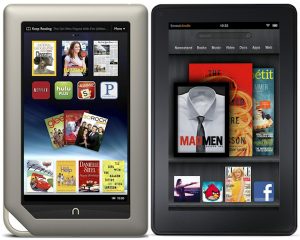Kindle Fire, Nook Tablet are better by design
 The best-designed Android tablets you can buy today aren’t the sleekest or the sexiest. They’re not the most powerful. And they don’t boast the largest or brightest displays. What they do have, however, are sales. The tablets? The Kindle Fire from Amazon and Barnes & Nobles’ Nook Tablet.
The best-designed Android tablets you can buy today aren’t the sleekest or the sexiest. They’re not the most powerful. And they don’t boast the largest or brightest displays. What they do have, however, are sales. The tablets? The Kindle Fire from Amazon and Barnes & Nobles’ Nook Tablet.
On a runway awash with thin, pretty models, it’s easy to overlook this pair of plain Janes. But don’t. They are two of the top three largest-selling Android tablets on the market. And their formula should serve as a model for how to succeed in this market if you’re a supplier that’s lacking a throng of breathless fanatics aching to snap up anything you sell.
According to comScore data for the US market, more Kindle Fires were in use than all other Android tablets combined at the end of February, just its third month on the market. comScore says that 54.4 percent of all Android devices accessing the Internet were Kindle Fires.
In the same breath in which comScore lauds the Kindle Fire, though, it snubs the Nook Tablet. You see, comScore excluded Nook Tablet from the study, classifying it instead as an e-reader rather than a tablet.
Microsoft, however, knows a good thing when it sees it. The software giant today invested $300 million in Barnes & Nobles’ ebook spin-off, Newco.
Regardless of whether Microsoft or comScore understand, both Barnes & Noble and Amazon know they hold the keys to this market: that a successful tablet is built around what I call an “anchor” app. Yes, you can load other apps, just as you would with a general-purpose tablet. But when it’s optimized for a popular app, it’s more compelling than one that’s being marketed by its form factor.
Think about it this way: would you be more or less likely to consider purchasing a Swiss Army Pocket-able Lump?
The Kindle Fire and the Nook Tablet were two of the four best-selling tablets last year. And they weren’t even available until the fall. The other two -- the Samsung Galaxy Tab and the iPad -- were launched in 2010.
Savvy CE manufactures have taken a lesson from Amazon and Barnes & Noble. Watch for them to unleash tablets designed around other anchor apps beginning late this year. A few of the more attractive anchors:
1. Gaming. I would argue that Sony’s PlayStation Vita is a gaming-centric tablet. It’s got a browser, Facebook, Twitter and access to an online store where you can go get other apps. Just last week, in fact, Sony added Skype to its app store.
I’d be shocked, by the way, if Microsoft wasn’t hard at work on an Xbox-inspired tablet to unveil after Windows 8 is on the market.
2. Video. I’m shocked that I still see people on planes who are watching movies on portable DVD players. Who is buying these dinosaurs? Regardless, there is obviously a ready-made opportunity for a well-designed video tablet to entice these consumers out of the disc age.
3. Personal Navigation. The window for this is limited, as the market for single-function GPS devices is already beginning to contract. Nevertheless, it is an established device market that a GPS-centric tablet could tap into and quickly exploit.
Needless to say, designing a tablet around a popular app isn’t the only ingredient for success. The Vita stands testament to that. As well, there will continue to be a market for sleek and shiny general-purpose tablets. But as Amazon and Barnes & Noble have shown, it’s much easier to coax consumers to pull out their wallets if your tablet does impeccably well what it is they want to do.
Remember: you can call it a knife and still tuck a toothpick and a fish scaler inside.
 Mike Feibus is principal analyst at TechKnowledge Strategies, a Scottsdale, Ariz., market research firm focusing on client technologies. You can reach him at mike at techknowledge-group dot com.
Mike Feibus is principal analyst at TechKnowledge Strategies, a Scottsdale, Ariz., market research firm focusing on client technologies. You can reach him at mike at techknowledge-group dot com.